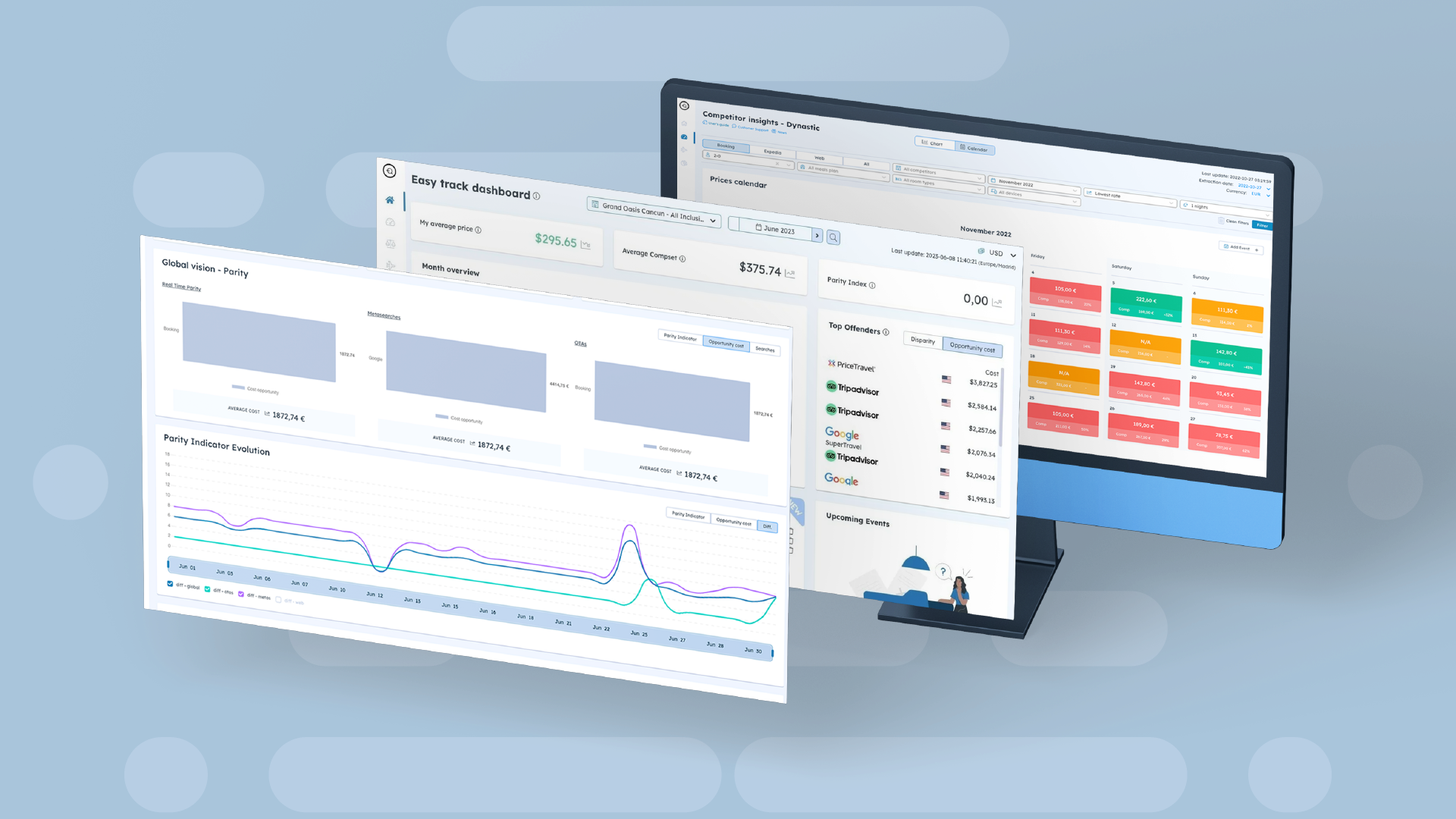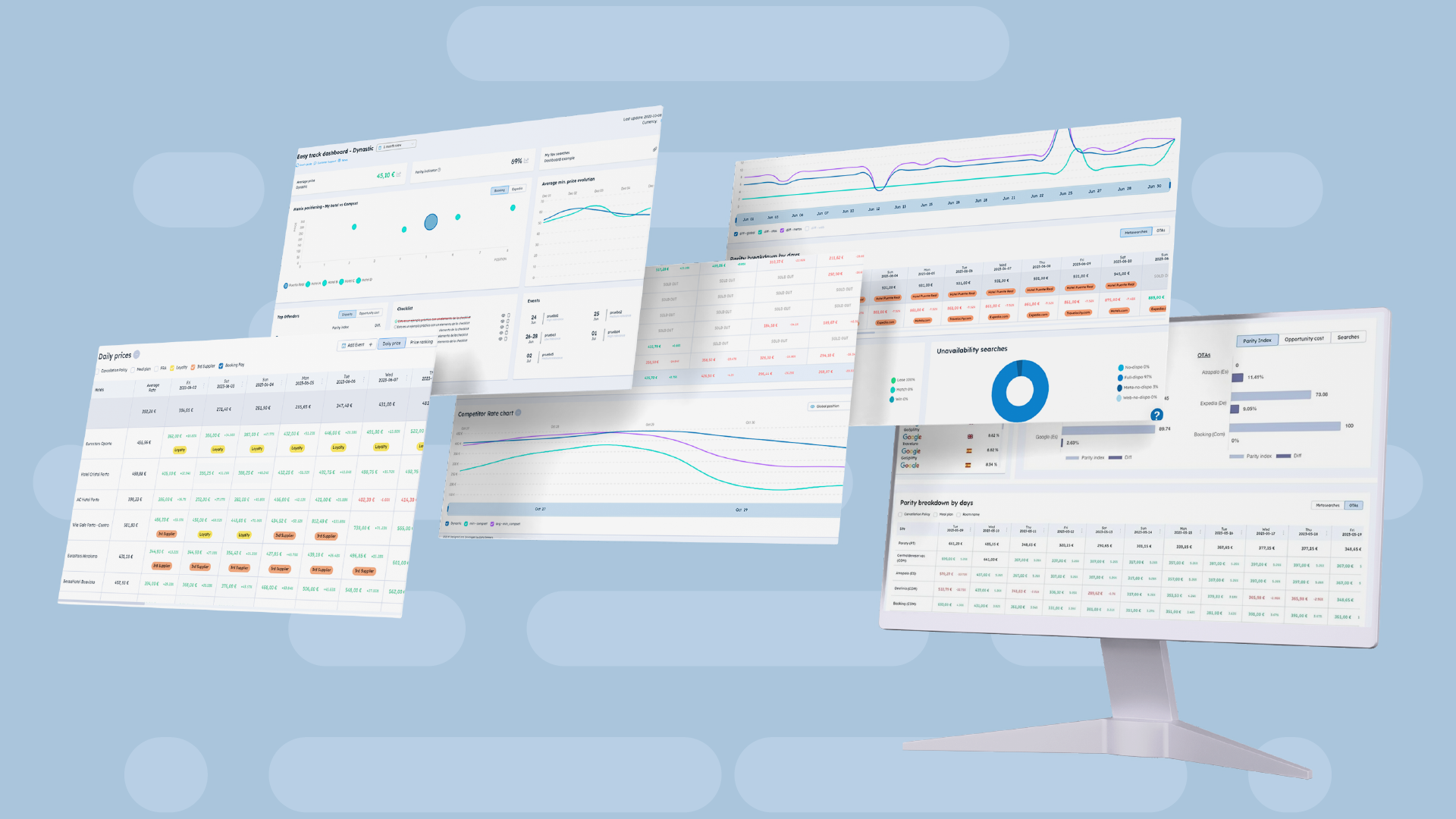8 Keys to save time analyzing data in your Rate Shopper
Revenue 15/10/2024
Today, we face a highly competitive environment, where accurate and timely information has become the central axis for strategic decision making. Rate volatility and increasing consumer sensitivity to prices have made obtaining accurate, real-time data and market trends no longer an option, but an imperative necessity. Below, we present several strategies to maximize the performance of your analysis while investing the least amount of time possible.
Although it may seem obvious, it is essential to remember your goals before you launch into analysis . Without a clear direction, it is easy to get lost in analyzing irrelevant data. Recommendations include taking a day to review and redefine your main goals. We often lose focus over time, and it is helpful to be clear about where we want to go. What results do you hope to achieve? This clarity will allow you to prioritize the most relevant information for your business strategy.
In the era of big data, we must coexist with the tendency to analyze every metric available. However, the key to success lies in identifying and prioritizing the KPIs that really drive your business. Don’t overload yourself with analyzing all the available data. The Pareto principle , also known as the 80/20 rule, applies perfectly in this context. Generally, 20% of your KPIs will influence 80% of your results .
Identify the key KPIs that influence your business the most and focus on the information that really impacts your establishment to avoid wasting time with less relevant data.
Creating a detailed roadmap for your analysis is essential to working efficiently. This document should be your daily, weekly, monthly and quarterly guide, specifying which aspects should be evaluated in each period:
Effectiveness in data analysis depends not only on the information itself, but also on how you process it. Recognizing your learning style and adapting data visualization directly influences your effectiveness:
If time is your problem, schedule rate shopper reports so that results are generated automatically. Automating reports can free up up to 30% of a revenue manager's time .
Set up your Rate Shopper to generate and send periodic reports on:
When you manage more than one property or business, not all data is equally relevant. Investing time in creating a custom dashboard with the specific KPIs you need will help you gain a clearer and more accurate view. You can make sure to include things like:
Efficient time management involves knowing which tasks you can delegate and which you can't. Identify those responsibilities that are important but don't require your immediate attention and assign them to members of your team. An advanced Rate Shopper will make delegating easier by setting up different access levels and generating automated reports that your team can analyze and present in summary form.
The hotel market is constantly evolving, and your analytics strategy must evolve with it. Cutting-edge technology, coupled with regular reviews of your analytics approach, can ensure you stay on the right track. Flexibility in your analytics strategy is key to staying competitive.
Are the KPIs you are monitoring still relevant? Have new competitors or market segments emerged that require attention? Are the data sources you are using still the most appropriate? Are there new functionalities in your Rate Shopper that you could improve?
Conduct these reviews at least quarterly to ensure your analytics strategy remains effective and aligned with your business objectives.
Keys to effective use of your Rate Shopper
1. Define your goals
Although it may seem obvious, it is essential to remember your goals before you launch into analysis . Without a clear direction, it is easy to get lost in analyzing irrelevant data. Recommendations include taking a day to review and redefine your main goals. We often lose focus over time, and it is helpful to be clear about where we want to go. What results do you hope to achieve? This clarity will allow you to prioritize the most relevant information for your business strategy.
2. Focus on the KPIs that drive your business
In the era of big data, we must coexist with the tendency to analyze every metric available. However, the key to success lies in identifying and prioritizing the KPIs that really drive your business. Don’t overload yourself with analyzing all the available data. The Pareto principle , also known as the 80/20 rule, applies perfectly in this context. Generally, 20% of your KPIs will influence 80% of your results .
Identify the key KPIs that influence your business the most and focus on the information that really impacts your establishment to avoid wasting time with less relevant data.
3. Document your procedure
Creating a detailed roadmap for your analysis is essential to working efficiently. This document should be your daily, weekly, monthly and quarterly guide, specifying which aspects should be evaluated in each period:
- Impact of competition on prices.
- Review of offers and strategy with TTOO.
- Analysis of demand and available quotas.
- Review of external events and promotions.
- Strategies in higher categories and marketing.
- Aerial data.
- Minimum stays.
- Long-term reservations and early booking discount.
- Distribution and discrepancies in the main OTAs.
4. Adapt the presentation of data to your style
Effectiveness in data analysis depends not only on the information itself, but also on how you process it. Recognizing your learning style and adapting data visualization directly influences your effectiveness:
- Visual : Use graphs or heat maps to quickly identify patterns.
- Structured : Opt for organized tables with clearly categorized data. This will allow you to compare and contrast information in a systematic way, ideal for more detailed analyses.
- Numeric : If you're a number buff, this may be your ally. Take advantage of the advanced analytical capabilities of tools like Excel or Power BI. These platforms will allow you to dig deeper into numbers, perform complex statistical analysis, and uncover insights that might not be apparent at a glance.
5. Schedule your results reports
If time is your problem, schedule rate shopper reports so that results are generated automatically. Automating reports can free up up to 30% of a revenue manager's time .
Set up your Rate Shopper to generate and send periodic reports on:
- Significant changes in competitor prices.
- Occupancy trends by segment.
- Performance of different distribution channels.
- Alerts about key events or dates that may impact demand.
6. Develop a personalized dashboard
When you manage more than one property or business, not all data is equally relevant. Investing time in creating a custom dashboard with the specific KPIs you need will help you gain a clearer and more accurate view. You can make sure to include things like:
- Price comparison with key competitors.
- Occupation trends.
- Performance by distribution channel.
- Evolution of price parity.
7. Delegate important, but not urgent, tasks
Efficient time management involves knowing which tasks you can delegate and which you can't. Identify those responsibilities that are important but don't require your immediate attention and assign them to members of your team. An advanced Rate Shopper will make delegating easier by setting up different access levels and generating automated reports that your team can analyze and present in summary form.
8. Review and adjust your analytics strategy regularly
The hotel market is constantly evolving, and your analytics strategy must evolve with it. Cutting-edge technology, coupled with regular reviews of your analytics approach, can ensure you stay on the right track. Flexibility in your analytics strategy is key to staying competitive.
Are the KPIs you are monitoring still relevant? Have new competitors or market segments emerged that require attention? Are the data sources you are using still the most appropriate? Are there new functionalities in your Rate Shopper that you could improve?
Conduct these reviews at least quarterly to ensure your analytics strategy remains effective and aligned with your business objectives.





